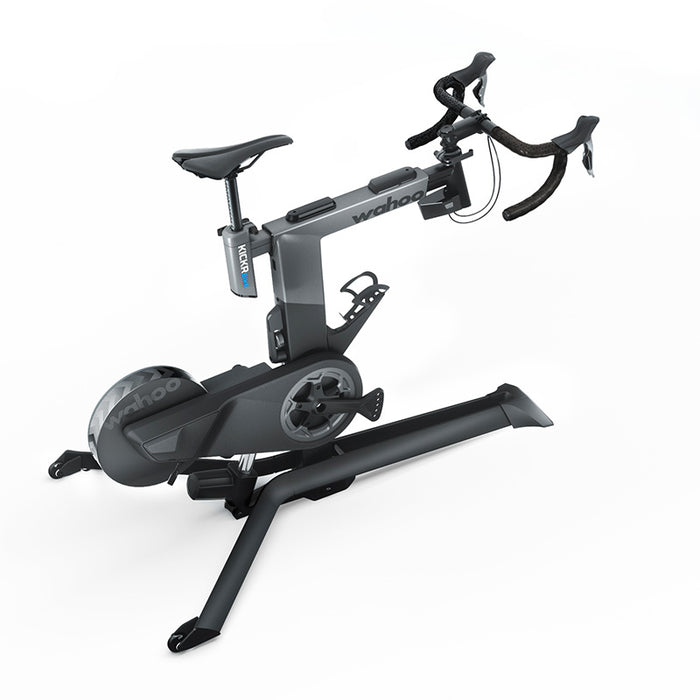
wahoo KICKR BIKE WIFI
incl. FREE shipping & free returns

As a racing cyclist, you want to constantly improve: faster, more enduring, and more efficient. But what if the key to these goals lies beyond two wheels? Rowing, often underestimated, offers an ideal complement to cycling training. It not only trains the entire body but also improves endurance, strength, and stability – crucial factors for every cyclist.
Von Björn Kafka |
3 minutes read time

Rowing targets almost all major muscle groups: legs, back, arms, and core. Rather than isolating the muscles, it trains them in a dynamic movement similar to the strain of cycling. The benefits are obvious:
Full-body workout: While cycling primarily targets the leg muscles, rowing simultaneously activates the core and upper body, preventing muscular imbalances.
Cardiovascular training: Rowing increases endurance and improves VO2Max, or maximum oxygen uptake. This means more power on long climbs or during intense sprints.
Protects your joints: Both cycling and rowing are gentle on your joints. This is ideal for balancing out intense training days while still training effectively.
Improve core stability: A strong core ensures a stable posture on the road bike, which increases the efficiency of the pedaling motion.
Injury prevention: Rowing helps strengthen the often neglected back and core muscles, which can help prevent poor posture and overuse injuries while cycling.
Road cycling primarily engages the leg muscles—such as the quadriceps, hamstrings, calves, and glutes—as well as the core, representing approximately 40–50% of the total musculature. Rowing, on the other hand, activates over 85% of all muscles, making it an ideal cross-training exercise for cyclists. It corrects muscular imbalances, specifically strengthens the back, shoulders, and core, improves posture, and promotes strength endurance and coordination skills—all with minimal joint wear.
One of the greatest strengths of rowing lies in its targeted strengthening of the legs—the engine of every racing cyclist. The leg kick, which initiates the movement in rowing, intensively trains the quadriceps, hamstrings, and calves. At the same time, rowing requires a high level of concentration on breathing technique, which improves oxygen efficiency. The result? Greater endurance over long distances and more explosive acceleration.
Additionally, rowing trains grip strength and forearm muscles—an often overlooked factor that can make a difference on long rides or technical descents. A strong upper body also helps better absorb shock and vibration, minimizing fatigue.

Rowing shouldn't be seen as a replacement, but rather as a complement to cycling training. Here are some tips for optimally integrating it into your training plan:
Recovery days: Use the rowing machine on days when you want to recover from intense cycling sessions. A moderate 30-minute rowing session improves circulation and promotes recovery.
High-intensity interval training: Rowing is ideal for HIIT workouts. For example, row 10 times for 1 minute at maximum intensity, followed by 1 minute of rest. This increases anaerobic capacity—perfect for sprints.
Offseason training: During the winter months, rowing can help you maintain your fitness and correct muscle imbalances, giving you a stronger start to the new cycling season.
Technique training: Pay attention to clean technique when rowing. The movement should be fluid and harmonious: legs, torso, arms – and back in reverse order. This will help you avoid incorrect strain.
A moderate cadence in road cycling is usually between 80 and 90 revolutions per minute (RPM). Similar to rowing at 20-22 rpm, cycling is all about maintaining a steady but sustainable pace.
Rowing is a versatile and effective cross-training exercise that helps road cyclists take their performance to the next level. It not only improves endurance and strength, but also promotes better posture and injury prevention. Those who incorporate rowing into their training plan will benefit from a stronger body and increased efficiency on the road bike. So, what are you waiting for? Get on the rowing machine – and feel the difference on two wheels!

Radfahren steht für Freiheit, Ausdauer und mentale Stärke. Doch gerade Frauen kennen auch die Schattenseite des Sports – wenn der Intimbereich nach langen Touren schmerzt, taub wird oder einfach nur brennt. Themen wie Reibung, Druckstellen oder Schwellungen sind tabu, aber sie betreffen viele. Zeit also, ehrlich darüber zu sprechen, wie Radfahren den weiblichen Intimbereich beeinflusst – und was wirklich hilft.

Gravelbikes sind in den letzten Jahren zu echten Allroundern auf dem Fahrradmarkt geworden. Sie kombinieren die Sportlichkeit eines Rennrads mit der Robustheit eines Mountainbikes und sind ideal für alle, die sowohl auf Asphalt als auch auf Schotterwegen unterwegs sein wollen. Doch gerade Einsteiger stellen sich oft die Frage: Bekommt man ein gutes, modernes Gravelbike schon für unter 1000 Euro? Die Antwort lautet: Ja – wenn man weiß, worauf es ankommt.

Wer viel Rennrad fährt, kennt das Gefühl: Anfangs ist alles wunderbar – der Wind pfeift, die Beine laufen, die Strecke ist dein Element. Doch nach einer Stunde meldet sich dein Hintern. Erst leicht, dann stechend, schließlich so brennend, dass jeder Tritt zur Qual wird. Willkommen im Club: Satteldruck und gereizte Haut gehören zu den häufigsten Beschwerden unter Radfahrer*innen – und kaum jemand spricht offen darüber.
Zeit, das Tabu zu brechen.